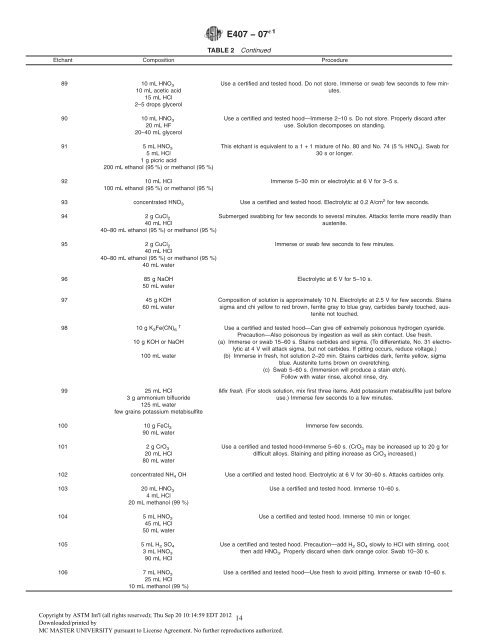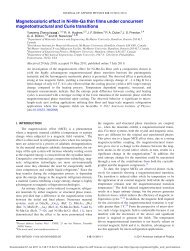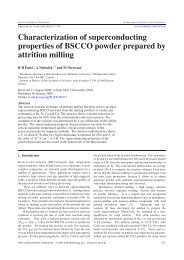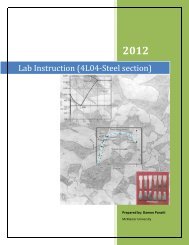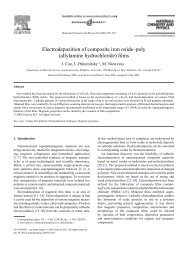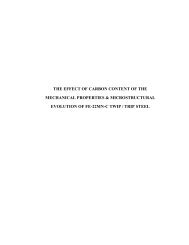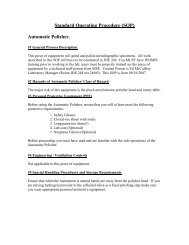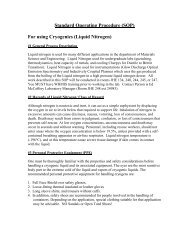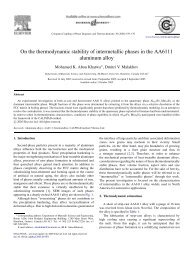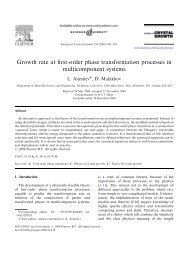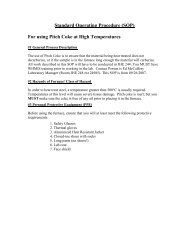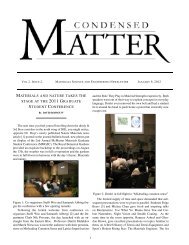E407-07 Microetching Metals and Alloys.pdf - McMaster Department ...
E407-07 Microetching Metals and Alloys.pdf - McMaster Department ...
E407-07 Microetching Metals and Alloys.pdf - McMaster Department ...
Create successful ePaper yourself
Turn your PDF publications into a flip-book with our unique Google optimized e-Paper software.
TABLE 2 Continued<br />
Etchant Composition Procedure<br />
89 10 mL HNO 3<br />
10 mL acetic acid<br />
15 mL HCl<br />
2–5 drops glycerol<br />
90 10 mL HNO 3<br />
20 mL HF<br />
20–40 mL glycerol<br />
91 5 mL HNO 3<br />
5 mL HCl<br />
1 g picric acid<br />
200 mL ethanol (95 %) or methanol (95 %)<br />
92 10 mL HCl<br />
100 mL ethanol (95 %) or methanol (95 %)<br />
Use a certified <strong>and</strong> tested hood. Do not store. Immerse or swab few seconds to few minutes.<br />
Use a certified <strong>and</strong> tested hood—Immerse 2–10 s. Do not store. Properly discard after<br />
use. Solution decomposes on st<strong>and</strong>ing.<br />
This etchant is equivalent to a 1 + 1 mixture of No. 80 <strong>and</strong> No. 74 (5 % HNO 3). Swab for<br />
30 s or longer.<br />
Immerse 5–30 min or electrolytic at 6 V for 3–5 s.<br />
93 concentrated HNO 3 Use a certified <strong>and</strong> tested hood. Electrolytic at 0.2 A/cm 2 for few seconds.<br />
94 2 g CuCl2 Submerged swabbing for few seconds to several minutes. Attacks ferrite more readily than<br />
40 mL HCl<br />
40–80 mL ethanol (95 %) or methanol (95 %)<br />
austenite.<br />
95 2 g CuCl 2<br />
40 mL HCl<br />
40–80 mL ethanol (95 %) or methanol (95 %)<br />
40 mL water<br />
96 85 g NaOH<br />
50 mL water<br />
97 45 g KOH<br />
60 mL water<br />
Immerse or swab few seconds to few minutes.<br />
Electrolytic at 6 V for 5–10 s.<br />
Composition of solution is approximately 10 N. Electrolytic at 2.5 V for few seconds. Stains<br />
sigma <strong>and</strong> chi yellow to red brown, ferrite gray to blue gray, carbides barely touched, austenite<br />
not touched.<br />
98 10 g K 3Fe(CN) 6 † Use a certified <strong>and</strong> tested hood—Can give off extremely poisonous hydrogen cyanide.<br />
Precaution—Also poisonous by ingestion as well as skin contact. Use fresh.<br />
10 g KOH or NaOH (a) Immerse or swab 15–60 s. Stains carbides <strong>and</strong> sigma. (To differentiate, No. 31 electrolytic<br />
at 4 V will attack sigma, but not carbides. If pitting occurs, reduce voltage.)<br />
100 mL water (b) Immerse in fresh, hot solution 2–20 min. Stains carbides dark, ferrite yellow, sigma<br />
blue. Austenite turns brown on overetching.<br />
(c) Swab 5–60 s. (Immersion will produce a stain etch).<br />
Follow with water rinse, alcohol rinse, dry.<br />
99 25 mL HCl<br />
3 g ammonium bifluoride<br />
125 mL water<br />
few grains potassium metabisulfite<br />
100 10 g FeCl 3<br />
90 mL water<br />
101 2 g CrO 3<br />
20 mL HCl<br />
80 mL water<br />
Mix fresh. (For stock solution, mix first three items. Add potassium metabisulfite just before<br />
use.) Immerse few seconds to a few minutes.<br />
Immerse few seconds.<br />
Use a certified <strong>and</strong> tested hood-Immerse 5–60 s. (CrO 3 may be increased up to 20 g for<br />
difficult alloys. Staining <strong>and</strong> pitting increase as CrO 3 increased.)<br />
102 concentrated NH 4 OH Use a certified <strong>and</strong> tested hood. Electrolytic at 6 V for 30–60 s. Attacks carbides only.<br />
103 20 mL HNO 3<br />
4 mL HCl<br />
20 mL methanol (99 %)<br />
104 5 mL HNO 3<br />
45 mL HCl<br />
50 mL water<br />
105 5 mL H 2 SO 4<br />
3 mL HNO 3<br />
90 mL HCl<br />
106 7 mL HNO 3<br />
25 mL HCl<br />
10 mL methanol (99 %)<br />
<strong>E4<strong>07</strong></strong> − <strong>07</strong> ´1<br />
Copyright by ASTM Int'l (all rights reserved); Thu Sep 20 10:14:59 EDT 2012<br />
14<br />
Downloaded/printed by<br />
MC MASTER UNIVERSITY pursuant to License Agreement. No further reproductions authorized.<br />
Use a certified <strong>and</strong> tested hood. Immerse 10–60 s.<br />
Use a certified <strong>and</strong> tested hood. Immerse 10 min or longer.<br />
Use a certified <strong>and</strong> tested hood. Precaution—add H 2 SO 4 slowly to HCl with stirring, cool;<br />
then add HNO 3. Properly discard when dark orange color. Swab 10–30 s.<br />
Use a certified <strong>and</strong> tested hood—Use fresh to avoid pitting. Immerse or swab 10–60 s.


